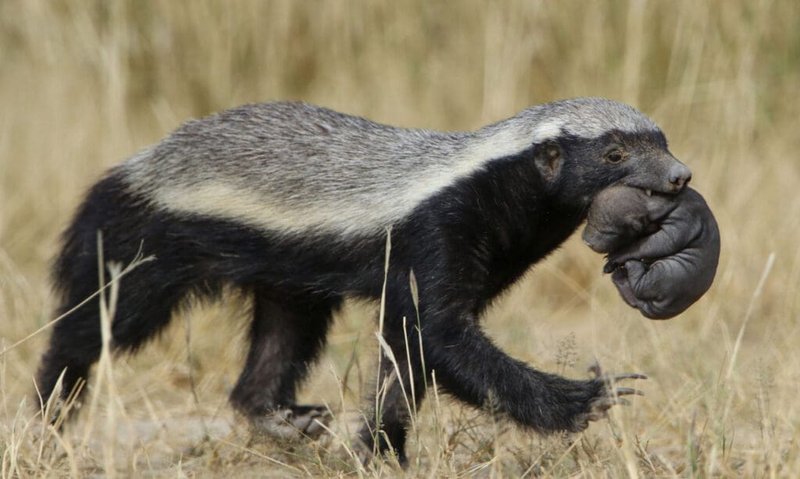
Now, you might be wondering why we need to talk about honey badgers specifically. After all, they’re not exactly the cuddliest critters. The truth is, honey badgers are remarkable animals with a reputation that can make anyone a bit nervous. They’re not just about their fearsome nature; they have incredible survival skills that make them a vital part of their ecosystems. So, understanding how to behave around them is crucial for your safety and theirs.
Understanding Honey Badgers: The Little Warriors of the Wild
Honey badgers, or *Mellivora capensis*, are not just tough little furballs; they’re also incredibly clever and adaptable. These creatures hail from Africa and parts of Asia and are famous for their fearless nature. They are known to take on animals much larger than themselves, including lions and snakes, often leaving their adversaries scratching their heads in disbelief. It’s like they have a tiny chip on their shoulder, ready to take on the world!
Their thick skin and resistance to snake venom make them especially formidable. Imagine wearing natural armor—this is why they’re often referred to as the “most fearless animal.” But don’t let their reputation fool you; honey badgers are also skilled foragers and play a valuable role in their habitat by controlling populations of pests. So, they’re not just fighters—they’re essential members of their ecosystem.
Knowing a bit about these creatures can help ease some worries about encountering one in the wild. But, make no mistake—if you see one, it’s best to stay alert and know how to handle the situation.
Stay Calm and Assess the Situation
If you find yourself in the presence of a honey badger, the first thing to do is to stay calm. Your heart may be racing, but panicking won’t help anyone. Instead, take a moment to assess the situation. Is the honey badger aware of your presence? Is it foraging for food or resting? Understanding its behavior can help determine your next move.
Honey badgers can exhibit curiosity. They may approach you, but remember that they’re just as likely to ignore you and continue with their business. If it’s focused on finding food or digging into the ground, it’s best to keep your distance. They might not be actively seeking a confrontation, but it’s wise to respect their space.
Here’s the thing: you want to avoid startling it. If you need to make your presence known, do so by talking softly or clapping your hands gently to alert it to your presence, without causing alarm. This way, you’re minimizing any surprise, which could lead to a defensive reaction.
Calculate Your Escape Route
Once you’ve assessed the situation and identified that the honey badger is nearby, it’s time to think about your exit strategy. The last thing you want is to find yourself stuck in a corner with an unpredictable animal. Identify where you can safely move away from it.
Take note of any clear paths or routes that lead away from the honey badger. If you’re in a group, make sure everyone knows the plan. It might sound a bit dramatic, but if you can move quietly and collectively, it lessens the chances of provoking any kind of response from the badger.
In case the honey badger starts showing signs of aggression—like growling or showing its teeth—it’s best to back away slowly and steadily. Never turn your back on it; instead, keep it in your peripheral vision as you make your way to safety.
Know How to React If Confronted
Sometimes, despite your best efforts, a honey badger might take an interest in you. This is where it’s crucial to know how to react if you feel threatened. First, remember that defensive behavior can vary. Some honey badgers might act aggressively, while others might simply show curiosity.
If a honey badger approaches aggressively, the best thing to do is to maintain your ground. Show it that you’re not a threat by standing tall without making sudden movements. Avoid making direct eye contact, which they can perceive as a challenge. Instead, turn slightly to the side and remain calm.
You might think about making some noise—like shouting or waving your arms—but this can sometimes escalate the encounter, so proceed with caution. If it charges at you, your best course of action is to move away quickly, using whatever obstacles you can find to create a barrier between yourself and the honey badger.
What to Do If You Get Bitten or Scratched
In a worst-case scenario, if a honey badger does manage to scratch or bite you, take it seriously. Honey badger bites can be nasty, not just because they hurt, but because of the potential for infection. Here’s how to handle the situation:
1. Get to Safety: Your first priority is to get away from the animal to avoid further injury.
2. Assess the Injury: Check the wound carefully. If it’s bleeding, try to apply pressure to stop it.
3. Seek Medical Attention: Regardless of how minor you think the injury may be, it’s best to see a doctor. They can clean the wound properly and check for any risk of infection or rabies.
Here’s the thing: even if the bite seems small, honey badgers have very strong jaws and can inflict serious wounds. Treatment from a medical professional can make all the difference in your recovery.
Learn About Honey Badger Habitats to Avoid Encounters
The best way to avoid a face-to-face meeting with a honey badger is to understand their habitats and typical behaviors. Honey badgers are typically found in open grasslands, savannahs, and forests. They tend to dig burrows or take over abandoned ones from other animals, so keep your eyes peeled if you’re in these environments.
Knowing the times they are most active can also help. Honey badgers are generally more active at night or during the early morning and late afternoon. If you’re hiking or exploring during these times, be extra cautious. Staying on marked trails and being aware of your surroundings can greatly reduce your chances of an encounter.
And if you’re lucky enough to spot one from a distance, simply enjoy the moment and appreciate their wild spirit—just ensure you’re keeping a safe distance.
Respect Their Role in the Ecosystem
Finally, it’s essential to respect honey badgers and understand their role in the ecosystem. They’re not just fierce creatures; they contribute to maintaining the balance of their environment by controlling populations of pests, like snakes and rodents. This means that finding a way to coexist is vital.
If you encounter one, remember that they’re a part of nature and deserve their space. By understanding their behavior and knowing how to react, you can enjoy the richness of wildlife without putting yourself or the animal at risk.
In the end, respecting the wild means respecting its inhabitants. So, while honey badgers may seem intimidating, they’re just doing their thing—surviving and thriving in a world that can be just as challenging for them as it is for us.
By being aware and taking the right steps, you can navigate your way through nature safely while fostering a deeper appreciation for the amazing creatures that call it home. Whether you’re hiking, camping, or simply exploring, embrace the adventure and the lessons from nature!

